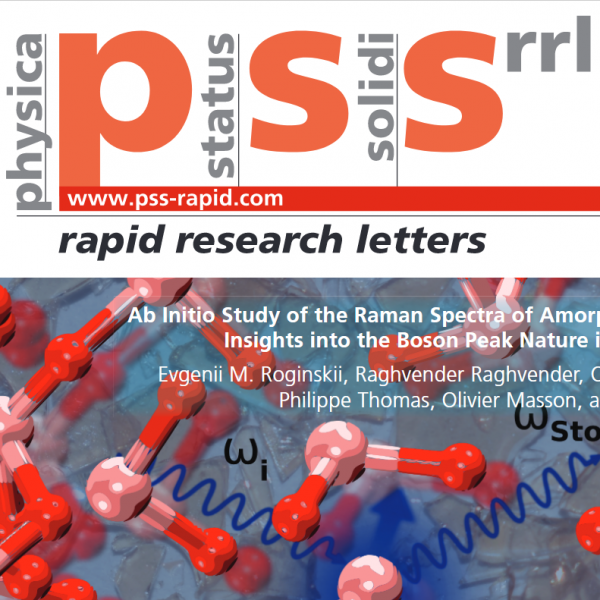
[Publication] A new implementation of Raman spectra calculations on amorphous systems through ab-initio and finite differences methods
In collaboration with Dr. Evgenii Roginskii from the Department of Solid State Spectroscopy of the Ioffe Institute (St. Petersburg, Russia), a team of researchers from the IRCER laboratory has developed a new calculations workflow addressing the modeling on Raman spectra on amorphous oxide systems based on large and periodic atomistic models with several hundred of atoms. This work has been published in the journal Physica Status Solidi Rapid Research Letters and was highlighted on the cover of Volume 17 published in April 2023.
Although Raman spectrum calculation techniques already existed and were successfully applied to crystalline systems or small molecular systems of a few dozen atoms, the case of large periodic systems remained a challenge. To this end, the team has developed a new workflow for calculating Raman spectra by combining density functional theory and the finite difference method, thus making it possible to obtain Raman spectra calculated on atomistic models issued from ab-initio molecular dynamics. These developments were tested on silica (SiO2) and tellurium dioxide (TeO2) and have demonstrated very good results in agreement with the experimental results. Indeed, this technique allows, for the first time on periodic and large size systems, to reproduce all the Raman bands with a very good accuracy.
Moreover, this method also gives access to the normal modes of vibration and thus allows the analysis of the origins of the calculated Raman bands by identifying the structural units at origin of the corresponding vibrations. The team was able to observe a high intensity peak in the low frequency range of the Raman spectrum attributed to the famous Boson peak. According to the atomic-scale analysis of the vibration eigenmodes, this peak is attributed to the collective vibrations of nanoclusters formed by the structural units of the glass.
More generally, this work paves the way for the systematic deployment of Raman spectra calculations on amorphous systems. It is also being pursued through the application of the technique to a set of atomistic models previously produced in the IRCER laboratory and also by tackling more complex materials, for example binary and ternary tellurium based materials.
Since many years, the IRCER laboratory has been collaborating with the Ioffe Institute around the calculation of optical and nonlinear properties of tellurite materials. This collaboration has been strengthened at the end of 2021 with the arrival of Dr. Evgenii Roginskii, as a visiting professor invited by the LABEX ∑-LIM and now addresses new fields of application such as bulk materials.
This work has been supported by the ANR via the TRAFIC and AMSES projects and by the Nouvelle Aquitaine region via the F2MH project. They are also supported by institutional grants from the Agence Nationale de la Recherche in the framework of the Investissements d’avenir program with the LABEX ∑-LIM.
About the publication
Ab-initio Study of the Raman Spectra of Amorphous Oxides: Insights into the Boson Peak Nature in Glassy TeO2
Evgenii M. Roginskii, Raghvender Raghvender, Olivier Noguera, Philippe Thomas, Olivier Masson, Assil Bouzid
Physica Status Solidi Rapid Research Letters – Volume 17, Issue 4
https://doi.org/10.1002/pssr.202200505
Manuscript received: 21 December 2022, Accepted manuscript online: 14 February 2023, Issue Online: 05 April 2023
Cover page: https://doi.org/10.1002/pssr.202370007
Crédit photo : Physica Status Solidi Rapid Research Letters


